Almaaz, Epsilon Aurigae (ε Aur), is a yellow-white supergiant star located in the constellation Auriga. With an apparent magnitude that varies from 2.92 to 3.83, it is on average the fifth brightest star in Auriga. It marks the left elbow of the celestial Charioteer. The distance of Almaaz is uncertain, but the star lies at least 1,350 light-years away.
Star system
Almaaz is the primary component in a multiple-star system classified as an Algol-type variable. The star system consists of at least two components that periodically eclipse each other as they orbit. The eclipses are accompanied by a flat-bottomed dimming every 27.1 years.
The gigantic system normally shines at magnitude 2.92 but dims to magnitude 3.83 for 640 to 730 days every 27 years. It also exhibits smaller variations in brightness with an amplitude of about 0.05 magnitudes due to pulsations over periods of 67 and 123 days. The pulsation period is not consistent.
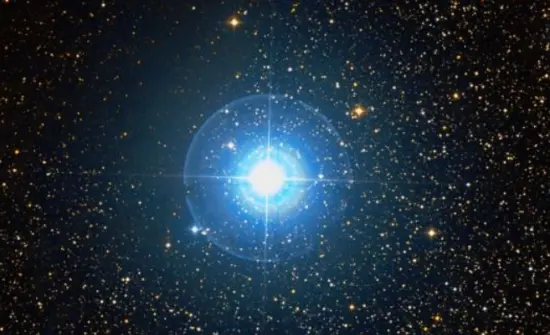
Almaaz (Epsilon Aurigae), image: Wikisky
The nature of the Epsilon Aurigae system is uncertain and remains a puzzle. The primary component, Epsilon Aurigae A (formally known as Almaaz) has the spectrum of a yellow-white supergiant of the spectral type F0 Iab. The star may also have the luminosity class of a giant or bright giant.
The star’s mass is estimated to be between 2.2 and 15 solar masses and its radius is between 143 and 358 solar radii. With a surface temperature of 7,750 K, Almaaz is 37,875 times more luminous than the Sun.
The values for the star’s mass come from a 2011 study, which proposed two models to explain the observed characteristics of Epsilon Aurigae. One is a high-mass model, where the primary component is a yellow supergiant star with a mass about 15 times that of the Sun. The other is a low-mass model, where Almaaz is an asymptotic giant branch star with a mass of about 2 solar masses. In the first model, Epsilon Aurigae A and B are separated by around 35 astronomical units and, in the second, they are only 18 light-years apart.
The companion, Epsilon Aurigae B, is believed to be a huge dark disk in orbit around an object that may be a binary star system composed of two small blue B-type stars. The true nature of the object has been a matter of debate for almost a century.
Epsilon Aurigae B is large enough to eclipse the enormous Epsilon Aurigae A for 2-year periods, yet it does not emit as much light as an object of its size normally would.
Epsilon Aurigae B is believed to have a mass between 6 and 14 solar masses and a radius of about 3.9 solar radii. It has an effective temperature of 15,000 K, indicating a B-type star.
The object is surrounded by a disk 3.8 astronomical units wide and 0.475 astronomical units thick. The disk blocks around 70% of the light of the primary star, allowing some of the light to be seen even when it eclipses the star.
The most widely accepted explanation as of 2008 is that Epsilon Aurigae B is a binary star enveloped in a massive dust disk. The object was once suspected to be a black hole or a large, semi-transparent star, but these theories have since been dismissed.
Observations during the 2009 – 2011 eclipse detected evidence of higher-speed material and the existence of a mass transfer stream between the two components.
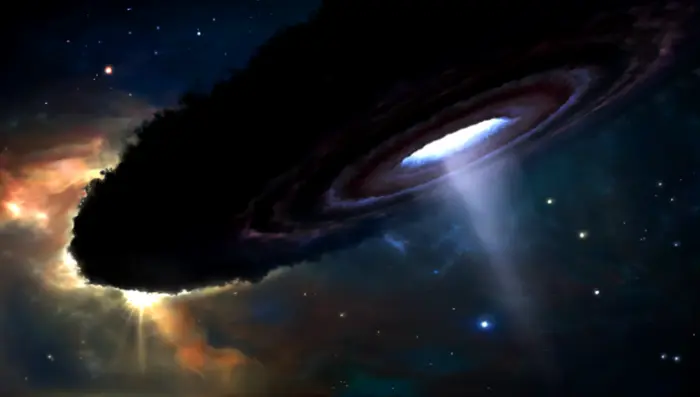
An artist’s illustration of the Epsilon Aurigae system during an eclipse. Artwork by Brian Thieme, file by Aaron Price (CC BY-SA 3.0)
Facts
Almaaz is part of an asterism known as Haedi (the Kids). It forms the star pattern with Saclateni (Zeta Aurigae) and Haedus (Eta Aurigae). Epsilon Aurigae was not originally part of the Kids but is now commonly included in the asterism.
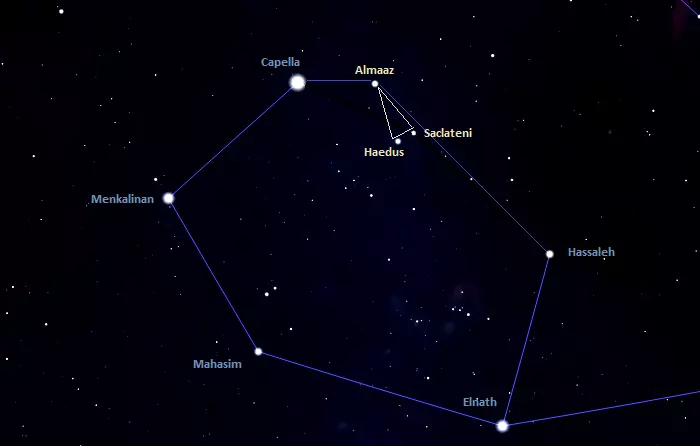
Haedi (the Kids), image: Stellarium
The variations in the brightness of Almaaz were first noted by German astronomer Johann Heinrich Fritsch in 1821. German astronomers Eduard Heis and Friedrich Wilhelm Argelander confirmed Fritsch’s suspicions between 1842 and 1848.
However, it was not until another German astronomer, Hans Ludendorff, began to study Epsilon Aurigae in detail that the nature of the brightness variations was understood. Ludendorff discovered the system to be an eclipsing binary variable. Like the prototype eclipsing variable Algol in the constellation Perseus, Almaaz consists of components that periodically block each other’s light when seen from Earth.
Ludendorff published his findings in an article titled “Investigations of the Light Changes of ε Aurigae” (Untersuchungen über den Lichtwechsel von ε Aurigae) in the journal Astronomische Nachrichten in 1904. In the article, he suggested that the system was an Algol-type variable.
In 1937, astronomers Gerard Kuiper, Otto Struve, and Bengt Strömgren proposed that the binary companion was an extremely cool semitransparent star that completely eclipsed the brighter star, but that it scattered the latter’s light, causing a dip in brightness.
Several other theories emerged in the 1960s. In 1961, Italian astronomer Margherita Hack suggested that the companion was a hot star surrounded by a shell. In 1965, Chinese astronomer Su-Shu Huang proposed that it was a large disk system, seen edge-on from our perspective.
In the 1970s, English astronomer Sir Robert Wilson explained the system’s sudden brightening during an eclipse by suggesting that the disk had a central opening.
In 2005, observations with the Far Ultraviolet Spectroscopic Explorer (FUSE) led to the hypothesis that the companion was a B5-type star.
Name
The name Almaaz (pronunciation: /ælˈmɑːz/) comes from the Arabic Al Maʽaz, meaning “the billy goat” or “goats.” It corresponds to the name of the brighter Capella, which is Latin for “nanny goat.” The name was mentioned in the 15th-century Persian astronomer Ulugh Beg’s star catalogue of 1437.
Almaaz is the traditional name of Epsilon Aurigae. The star was also known as Al Anz and Haldus. The name Al Anz was used by the 13th-century Persian astronomer Zakariya al-Qazwini.
The name Almaaz was officially approved by the International Astronomical Union’s (IAU) Working Group on Star Names (WGSN) on February 1, 2017.
In Chinese astronomy, Almaaz was known as 柱一 (Zhù yī), the First Star of Pillars. The Pillars asterism was formed by Almaaz with Saclateni (Zeta Aurigae), Haedus (Eta Aurigae), Upsilon Aurigae, Nu Aurigae, Tau Aurigae, Chi Aurigae, 26 Aurigae, and an unknown ninth star. The asterism was part of the Net mansion, one of the western mansions of the White Tiger.
Location
Almaaz is easy to find because it is part of Auriga’s hexagon, a prominent asterism that makes the constellation easy to identify. Almaaz appears right next to Capella, the brightest star in Auriga and the sixth brightest star in the sky.
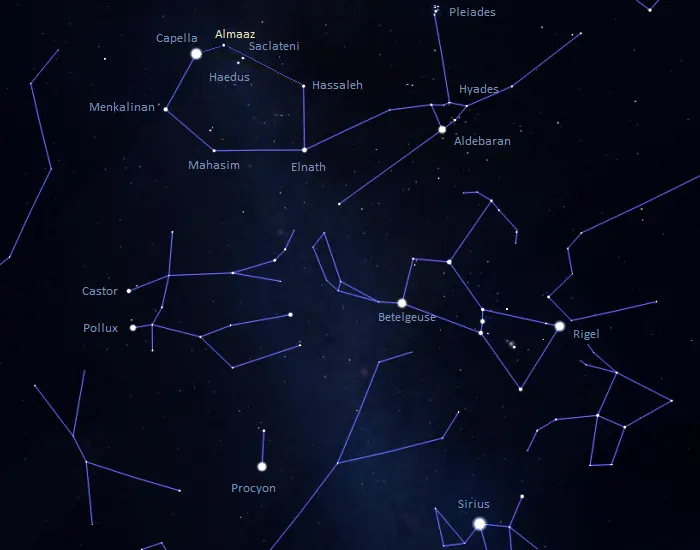
Almaaz location, image: Stellarium
Epsilon Aurigae appears in the same region of the sky as the open cluster NGC 1644. Located just west of Almaaz, the star cluster has a visual magnitude of 7.6 and an apparent size of 18 arcminutes. It lies approximately 4,200 light-years away.
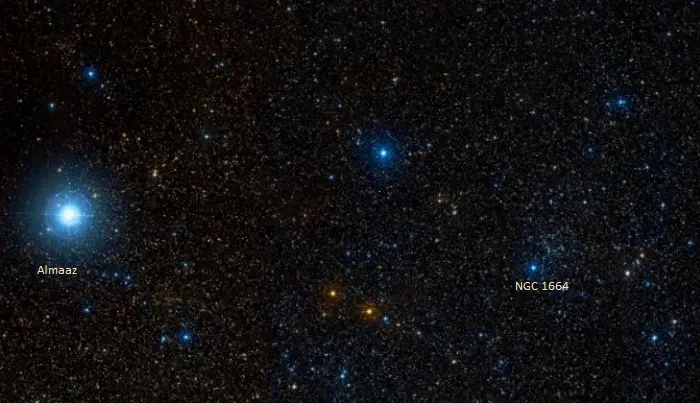
Almaaz and NGC 1664, image: Wikisky
Constellation
Almaaz is located in the constellation Auriga. Representing the celestial Charioteer, Auriga is one of the Greek constellations catalogued by Claudius Ptolemy of Alexandria in his Almagest in the 2nd century CE. In Greek mythology, the constellation is associated with Erichthonius of Athens, the inventor of the four-horse chariot (the quadriga), as well as with the goat Amalthea, who nursed the infant Zeus.
Auriga is one of the most recognizable northern constellations. Its five brightest stars – Capella, Menkalinan, Mahasim, Hassaleh, and Almaaz – form a distinctive hexagon in the sky with Elnath, the star that marks the northern horn of Taurus.
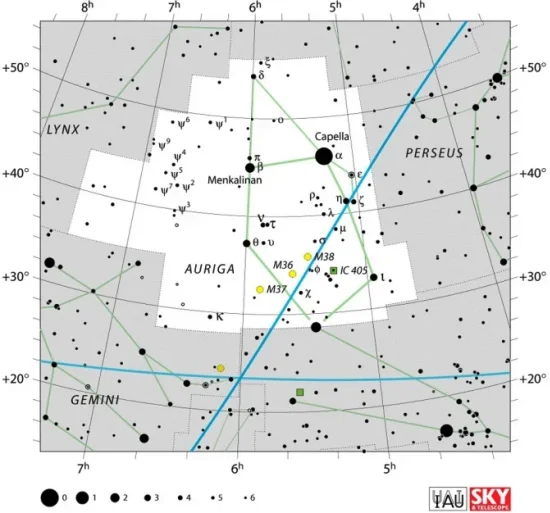
Auriga constellation map by IAU and Sky&Telescope magazine
Capella, the constellation’s luminary, is the sixth brightest star in the night sky. It is part of a quadruple star system composed of two binary stars. Menkalinan is an Algol-type eclipsing variable star, Mahasim is an Alpha2 Canum Venaticorum variable, and Hassaleh is an evolved orange bright giant star.
Other notable stars in Auriga include the eclipsing binary Zeta Aurigae (Saclateni), the hot blue main sequence star Eta Aurigae (Haedus), the young T Tauri variable RW Aurigae, and the Orion variable AE Aurigae, the star that illuminates the Flaming Star Nebula.
The hexagon pattern can be used to find several well-known deep sky objects in Auriga. These include the bright open clusters M36, M37, M38, and NGC 2281, the Kite Cluster (NGC 1664), the protoplanetary Westbrook Nebula, the emission and reflection nebulae IC 405 (the Flaming Star Nebula) and NGC 1931 (the Fly Nebula), and the emission nebulae IC 410 (the Tadpole Nebula) and IC 417 (the Spider Nebula).
The best time of the year to see the stars and deep sky objects of Auriga is in late February and early March, when the constellation rises high above the horizon in the evening. The entire constellation is visible from locations north of the latitude 40° S.
The 10 brightest stars in Auriga are Capella (Alpha Aur, mag. 0.08), Menkalinan (Beta Aur, mag. 1.90), Mahasim (Theta Aur, mag. 2.62 – 2.70), Hassaleh (Iota Aur, mag. 2.69), Almaaz (Epsilon Aur, mag. 2.92 – 3.83), Haedus (Eta Aur, mag. 3.18), Saclateni (Zeta Aur, mag. 3.70 -3.97), Delta Aurigae (mag. 3.715), Nu Aurigae (mag. 3.957), and Pi Aurigae (mag. 4.25).
Almaaz – Epsilon Aurigae
| Spectral class | F0 Iab (or II-III) + ~B5V or A9Ia |
| Variable type | Algol |
| U-B colour index | +0.30 |
| B-V colour index | +0.54 |
| Apparent magnitude | 2.92 – 3.83 |
| Absolute magnitude | -9.1 |
| Distance | 2,130 – 4892 light years (653 – 1,500 parsecs) or 1,350 ± 300 light years (Gaia) |
| Parallax | 0.9879 ± 0.1792 mas |
| Radial velocity | 10.40 ± 0.4 km/s |
| Proper motion | RA: 0.883 ± 0.206 mas/yr |
| Dec.: −3.065 ± 0.183 mas/yr | |
| Constellation | Auriga |
| Right ascension | 05h 01m 58.1343686753s |
| Declination | +43° 49′ 23.917115327″ |
| Names and designations | Almaaz, Epsilon Aurigae, ε Aur, 7 Aurigae, HD 31964, HR 1605, HIP 23416, SAO 39955, BD+43°1166, FK5 183, GC 6123, GCRV 2970, AG+43 552, GSC 02907-01275, PPM 47627, ALS 8131, JP11 959, AAVSO 0454+43, PLX 1122, IRAS 04583+4345, 2MASS J05015812+4349241, UBV 4807, UCAC3 268-74264, TYC 2907-1275-1, Gaia DR2 205499655242974464, ADS 3605 A, CCDM J05020+4350A, IDS 04548+4341 A, WDS J05020+4349A |
Epsilon Aurigae A
| Mass | 2.2 – 15 M☉ |
| Luminosity | 37,875 L☉ |
| Radius | 143 – 358 R☉ |
| Temperature | 7,750 K |
| Rotational velocity | 54 km/s |
| Surface gravity | ≲ 1.0 cgs |
Epsilon Aurigae B
| Mass | 6 – 14 M☉ |
| Radius | 3.9 ± 0.4 R☉ |
| Temperature | 15,000 K |
| Surface gravity | 4.0 cgs |